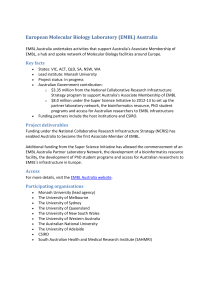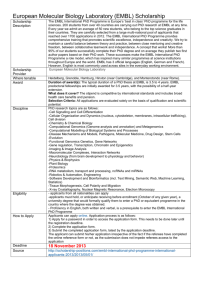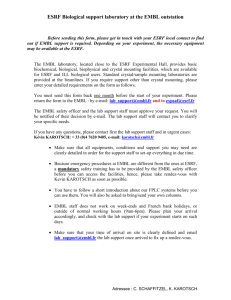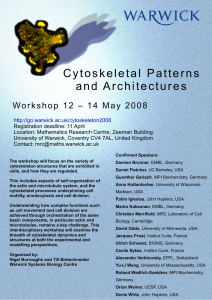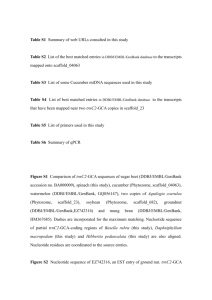Postdoctoral Programme EMBL An exciting and stimulating environment European Molecular Biology Laboratory
advertisement
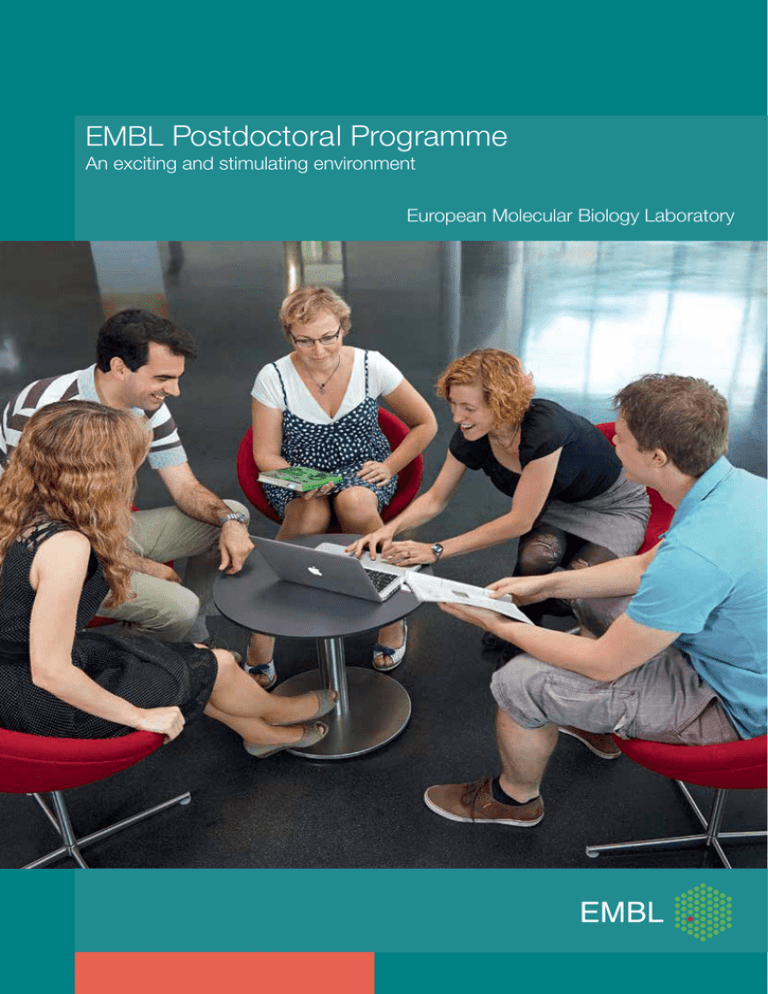
EMBL Postdoctoral Programme An exciting and stimulating environment European Molecular Biology Laboratory Table of Contents Welcome to EMBL 5 World-class, international and exciting About EMBL 8 The EMBL postdoctoral programme Research at EMBL Life after EMBL 10 12 Meet some of our former postdocs Contact us 6 14 16 19 “EMBL is proud to have influenced and contributed to the scientific development of several generations of postdoctoral fellows, many now leaders in academia and industry. Our fellows play a pivotal role in the success of our research programme. EMBL in turn is committed to their advancement by providing resources, sharing access to an outstanding global scientific network, and offering the skills development required for a bright future.” Iain Mattaj, EMBL Director General 3 Welcome to EMBL Choosing the right postdoctoral position is one of the most important decisions of your career. During your time as a Postdoc you will make the transition towards becoming an independent scientist. An inspiring postdoctoral experience goes beyond experiments conducted in the lab – it encompasses continuous scientific training, a wealth of opportunities for professional networking, guidance and training to support your personal and career development as well as stimulating a rewarding work-life balance. At EMBL, we offer an exciting and well-structured environment to help you achieve this transition productively and successfully. Become an EMBL postdoctoral fellow and you will become a highly valued member of one of the world’s top research communities, known for extensive collaboration between groups. EMBL – Europe’s flagship laboratory for the life sciences – is international, innovative and interdisciplinary: its 1700 employees from more than 60 nations represent scientific disciplines including biology, medicine, chemistry, physics, mathematics, engineering and computer sciences. Research is conducted by some 85 independent groups covering all aspects of natural sciences contributing to the advancement of molecular biology. EMBL’s postdoctoral community comprises about 250 members across our five sites. We are committed to creating a welcoming environment that provides the right conditions for career advancement. The importance of our postdoctoral fellows is recognised in the support we offer, including dedicated training and development to enhance career planning and personal skills. We appreciate that a postdoctoral period can be a time of personal reflection of longterm goals and expectations. Our dedicated mentoring programme not only helps you to make the most of your postdoctoral experience, but also helps to define and achieve career objectives by providing an additional source of guidance. Colleagues active in the Postdoctoral Association and the Staff Association are equally available to support initiatives relating to professional development, to sponsor networking events and to help foster postdoctoral life at EMBL in general. Access to childcare enables those with families to successfully combine work and family life. 5 As highly trained scholars, postdoctoral fellows contribute significantly to EMBL’s ambitious and exciting research programme. EMBL postdocs have a track record of success, with more than 90 per cent of postdoctoral alumni remaining active in research. If you want to be a part of this vibrant community, read on – we look forward to warmly welcoming you to EMBL. Helke Hillebrand (middle), Academic Coordinator and Dean of Graduate Studies; Detlev Arendt, Senior Scientist and Academic Mentor Postdoctoral Training; Brenda Stride, EMBL Postdoctoral Programme Administrator. World-class, international and exciting Why join EMBL? EMBL provides an exciting and stimulating environment for postdoctoral fellows, with access to everything you need at this critical career stage: World-class research labs and facilities EMBL labs are equipped with the latest technologies, allowing you to realise ambitious research projects. Active seminar programme We welcome prominent speakers from institutes around the world to speak to our scientific community. In-house research is actively communicated via departmental seminars involving the participation of faculty, postdoctoral fellows, and PhD students. Dedicated training and career development EMBL is committed to ensuring all staff have access to relevant transferable skills to build their careers with courses ranging from language training to grant writing. The postdoctoral programme also offers dedicated workshops and events aimed at helping our postdoctoral community explore and prepare for the next career step. Vibrant international and interdisciplinary atmosphere Science at EMBL is interdisciplinary, international and innovative. EMBL’s 1700 employees represent more than 60 nationalities. Scientists at all career stages are involved in and foster extensive collaboration across the five EMBL sites. On an international scale researchers at EMBL are widely connected: an average of 900 collaborations are entertained across EMBL each year. Access to scientific expertise and support EMBL’s onsite core facilities work hand in hand with the scientific community to develop and provide access to state-of-the-art technologies, equipment and expertise for the EMBL community and its member states. The core facilities are composed of the Advanced Light Microscopy Facility, the Electron Microscopy Core Facility, the Chemical Biology Core Facility, the Flow Cytometry Core Facility, the Genomics Core Facility, the Protein Expression and Purification Core Facility, and the Proteomics Core Facility. Staff Association Composed of elected representatives, the Staff Association is ‘the voice’ of EMBL employees and also includes representatives from the postdoctoral community. It is consulted for policy changes and administrative affairs that directly affect all members of personnel. Who are we looking for? Postdocs at EMBL have a wide range of backgrounds, including biology, chemistry, biochemistry, molecular biology, engineering, medicine, physics, mathematics, computer science and bioinformatics. Interdisciplinarity is an important strength of research at EMBL and, as such, we welcome fellows interested in moving into a new area of research. Excellence, creativity, diligence and innovation are the guiding principles for our research community. 7 About EMBL The European Molecular Biology Laboratory (EMBL) EMBL is Europe’s flagship laboratory for the life sciences, and one of the world’s leading research institutions. EMBL operates from the main laboratory in Heidelberg, Germany, and four outstations across Europe: in Hinxton near Cambridge (the European Bioinformatics Institute, EMBL-EBI), Hamburg, Grenoble, and Monterotondo, near Rome. Heidelberg: main laboratory Hinxton: European Bioinformatics Institute (EMBL-EBI) Grenoble: research and services for structural biology EMBL Heidelberg is home to five research units, central scientific services, the administration, and the laboratory’s technology transfer arm, EMBL Enterprise Management (EMBLEM). Heidelberg is the largest centre for biomedical research in Germany and there are many links between EMBL scientists and local research institutions. The European Bioinformatics Institute (EMBL-EBI) offers the scientific community access to a variety of bioinformatics services, alongside which a number of active research groups work in areas that complement and extend these services. It is located on the Wellcome Trust Genome Campus in Hinxton, near Cambridge, UK. The main Laboratory of EMBL is nestled in the forested hills above Heidelberg, Germany. About 960 staff members work closely in its integrated research units. The large number of university students contribute to Heidelberg’s young and dynamic flair. The narrow, picturesque streets of the Old Town are filled with theatres, cinemas and countless restaurants and pubs. The famous Schloss (castle) is majestically set above the centre of the city. The campus provides an exceptionally stimulating environment in which to conduct topquality research, and is regularly visited by some of the greatest minds in the biomedical sciences. EMBL-EBI is housed in modern buildings in a beautiful rural setting and is only a stone’s throw from the historic university town of Cambridge, where ancient college buildings sit alongside peaceful meadows. As one of the world’s most important academic centres for almost 800 years, Cambridge has an unrivalled reputation for scientific achievement. EMBL Grenoble undertakes research in structural and molecular biology, notably using crystallographic techniques to obtain atomic structures of proteins and nucleic acids. Furthermore, this EMBL site builds and operates beamlines for macromolecular crystallography, develops instrumentation and techniques, and provides facilities and expertise to visitors in collaboration with its campus partners, the European Synchrotron Radiation Facility (ERSF) and the Institut LaueLangevin (ILL). The outstation is also part of the Unit of Virus Host Cell Interactions (UVHCI). Situated in the heart of the Alpine mountain range, Grenoble is the capital of the French Alps and a lively university town, with students representing one-tenth of the population. Residents enjoy activities such as hiking, mountain climbing, skiing and snowboarding, rafting, kayaking and canoeing, as well as a wide variety of cultural activities in the city. The cornerstones of EMBL’s mission are to: perform basic research in molecular biology provide advanced training at all levels offer services to scientists in the member states develop new instruments and methods actively engage in technology transfer Hamburg: research and services for structural biology Monterotondo: mouse biology unit Hamburg Hinxton EMBL Monterotondo, near Rome, focuses EMBL Hamburg has an ambitious research programme for structures of multifunctional on mouse genetics and functional genomproteins and protein complexes of biomedical ics, and offers expertise in mammalian relevance. It also develops novel, innovative physiology and production of mouse models technologies in structural biology, such as of human diseases. Researchers form dyhighthroughput crystallisation and data namic partnerships with other international interpretation software. Scientists here opresearch and clinical centres. The outstaerate cutting-edge synchrotron radiation tion shares a campus with Italian national beamlines and make the outstation’s worldresearch groups (IBC-CNR) and the headHeidelberg quarters of the the European Mouse Mutant leading facilities and expertise open to the Archive (EMMA). research community. The EMBL Monterotondo campus in Italy is situated in a green park, 20 km north of central Rome. The Eternal City is an easy train ride away, and the nearby Lazio countryside features medieval hill towns, spectacular mountain terrain and lakes for hiking, biking, skiing Grenoble and swimming. 9 EMBL member states are: Austria, Belgium, Croatia, the Czech Republic, Denmark, Finland, France, Germany, Greece, Iceland, Ireland, Israel, Italy, Luxembourg, the Netherlands, Norway, Portugal, Spain, Sweden, Switzerland and the United Kingdom Associate member states: Argentina, Australia Prospective member state: Slovak Republic The city of Hamburg in Germany offers a wide spectrum of activities from art exhibitions, music, theatres, sports and the ambience of a large city. EMBL Hamburg is located on the campus of the German photon science research centre DESY, which hosts worldleading synchrotron and laser facilities namely PETRA-III, FLASH and X-FEL. Israel Monterotondo The EMBL Postdoctoral Programme Get in touch If you are interested in becoming an EMBL postdoc, the first step is to contact the group leader of your choice directly to ask about opportunities. Contact details and information about the research topics of each group can be found under ‘Research’ at www.embl.org. Employment EMBL offers attractive employment conditions including competitive salaries, additional allowances dependent on family circumstances, generous annual leave entitlement and broad social security benefits. The maximum length of a postdoctoral stay at EMBL is five years. Entry routes Most postdoctoral fellows enter EMBL via one of the following entry routes: with external funding in the form of individual postdoctoral fellowships on grant money available to the group leader by applying to some of the postdoctoral fellowships offered as specific positions on our job pages (www.embl.org/jobs) via one of the EMBL dedicated programmes described on the opposite page Social security benefits Social security benefits include comprehensive health care benefits for fellows and their families and coverage by the EMBL pension scheme. Included in the pension scheme are a number of social security benefits including retirement pension, invalidity pension and survivor benefits. The pension contribution is portable, meaning that in most cases, EMBL fellows will receive a lump sum payment upon departure from EMBL that incorporates both the fellow’s and EMBL’s contribution to the scheme. Collaboration and community You will join a community that encourages collaboration, scientific exchange and openness to new ideas. Networking is an important part of the postdoctoral experience at EMBL, and the Postdoctoral Association and EMBL postdoctoral office work together to organise events and opportunities that unite fellows from all disciplines and sites. We look forward to hearing from you. About 250 postdocs across the five EMBL sites Fellows have access to a wide range of courses on offer Fellows are supported by an established second mentor programme The postdoctoral office organises career development events Active postdoctoral association promotes the views of the postdoctoral community within EMBL and organises networking events Dedicated programmes EMBL has three dedicated fellowship programmes to fund postdoctoral research at EMBL: the EMBL Interdisciplinary Postdocs (EIPOD) Fellowship, the EMBL-EBI-Sanger Postdoctoral (ESPOD) Fellowship and the EMBL-EBI BRC Postdoctoral fellowship (EBPOD). EMBL Interdisciplinary Postdocs (EIPOD) Cross-disciplinary fellowship Three years secured funding Open to all nationalities Up to 20 fellowships per year Supported by EMBL and Marie Curie Actions The EIPOD programme underlines EMBL’s strong commitment to promoting interdisciplinary research. EIPOD fellows work across two labs, preferably in different units. Each project has one scientific supervisor Co-funded by the European Union who officially hosts the EIPOD, but all projects involve extensive collaboration with the partner laboratory. EIPOD projects capitalise on synergies emerging at the borders of overlapping yet separate scientific fields, and involve transferring techniques to a novel context. You are invited to design and propose an interdisciplinary project of your choice or develop a listed project idea into a multidisciplinary project according to your research interests. For more information and to apply online please visit www.embl.org/eipod. EMBL-EBI-Sanger Postdocs (ESPOD) EMBL-EBI and the Wellcome Trust Sanger Institute have joined forces to offer postdoctoral fellowships focusing on projects that combine experimental (wet-lab) and computational (dry-lab) approaches. For more information about the ESPOD fellowship programme please visit www.ebi.ac.uk/research/postdocs/ espods. EMBL-EBI BRC Postdocs (EBPOD) EMBL-EBI and NIHR Cambridge Biomedical Research Centre (BRC) have launched a postdoctoral programme that builds on the collaborative relationship between the two institutes. The programme offers positions for projects that apply computational approaches to translational clinical research involving human subjects. For more information about the EBPOD fellowship programme please visit www.ebi. ac.uk/research/postdocs/ebpods. 11 Research at EMBL Bioinformatics and computational biology Molecular biology produces an overwhelming amount of data, which have to be collected, organised and made available. Large databases are needed to store this information, which includes DNA and protein sequences, molecular structures, genome information and scientific literature. EMBL establishes, updates and curates such databases and makes them freely available worldwide. In addition, research groups focus on computational biology to develop programs and models that simulate dynamic processes. Others generate tools to extract information by analysis of data from diverse fields of biomedicine. What kind of information can we extract from DNA sequences and genomes? How can proteins and their interactions be classified and understood? What do biological data tell us about evolution and the relation ship between species? How can computer models help us to understand complex physiological processes? Cell biology and biophysics Cell biology comprises all aspects of the life and structure of a cell and its function in the context of a whole organism. Researchers at EMBL try to understand molecular mechanisms and physical principles that give rise to cellular organisation using computer simulation and cutting-edge visualisation technologies such as live imaging and fluorescence microscopy. How do structures arise inside the cell? What kind of machinery does a cell need to divide and how does it work? How do cellular systems combine to build an organism? How can complex cell behaviours be modelled by computers and what can we learn from computer models? Developmental biology A single cell contains all the information needed to develop into a multicellular organism. Its instruction manual is DNA, identical copies of which are passed on to all the cells of the emerging body. So why does a brain cell differ from a heart cell, which in turn is different from a blood cell? EMBL scientists use microscopy, computer and microarray analysis and genetics to observe development from a single cell to a complex animal. They use different model organisms to find out what goes wrong when animals carry mutations in certain genes. How does an organism arise from a single cell? Which regulatory mechanisms give cells their unique identities? How are these processes disturbed in disease? How do organs and tissues develop? Systems Biology links all levels of biological organisation, bridging the gaps between different scales from molecules to organisms and even entire ecosystems. EMBL fosters interdisciplinary exchange via its overarching centres for Biological Modelling, Biomolecular Network Analysis, Molecular and Cellular Imaging, and Statistical Data Analysis. Genome biology The genome encodes the information that coordinates cellular processes, from RNA transcription to the regulation of protein machinery. The gene expression programme takes a systems biology approach to unravel these complex processes at all scales, integrating global approaches at a genome level with detailed mechanistic investigation at a molecular level. How do molecules interact within networks to enable complex bio logical processes? How is gene expression regulated through the interplay of epigenetic modifications and transcriptional control? How is protein function controlled through post-trans lational modifications and protein interactions? How does variation in genomes lead to phenotypic diversity, including diseases? Mouse biology Mice and humans are genetically very alike, making the mouse an ideal model organism to study human disease. Researchers at EMBL study mice with conditions similar to depression, heart failure, multiple sclerosis and chronic anxiety to gain insight into human disorders. Using genetic and behavioural techniques they also assess important aspects of mammalian physiology, including muscle and nerve cell regeneration, blood stem cell differentiation and embryonic development, and complex behaviours like learning, memory and fear responses, asking such questions as: How does normal physiology change in disease? What are the genetic and molecular mechanisms under pinning a disorder? What do mouse behaviour and physiology tell us about humans? How can we cure diseases in mice and ultimately humans? Structural biology Proteins have unique, three-dimensional structures, which enable them to interact and become part of the molecular machines that carry out almost all processes in a cell. One wrongly built protein can threaten the function of an entire cell. To understand protein structures and interactions, EMBL scientists employ tools including powerful X-ray sources, electron microscopes and methods relying on magnetic resonance. How do molecules interact in complexes? Through which molecular mechanisms do proteins function in the cell? Can you predict a molecule’s function from its 3D structure? How do viruses and bacteria infect human cells and cause diseases? 13 Meet some of our former postdocs “I was attracted by the scientific excellence at EMBL, the cutting-edge technology available, and the international ambience.” Daniel Gerlich Nationality: German Daniel joined EMBL as a postdoc in 2002. He is currently a senior research group leader at the Institute of Molecular Biotechnology, Austria. While at EMBL, Daniel worked on various projects aimed at understanding chromosome organisation in vertebrates during the cell cycle. Key to his postdoctoral experience was the collaborative spirit amongst research groups, within and outside of EMBL: “I valued the frequent scientific discussions with postdocs, PhD colleagues and PIs throughout our research unit and beyond.” His most challenging task was to progress from postdoctoral fellow to group leader, but even here EMBL proved its worth: ”I am grateful for the helpful advice and generous support that I received from my postdoc supervisor during the transition to build up my independent research group.” Now working as a senior research group leader at the Institute of Molecular Biotechnology in Vienna, Austria, Daniel continues to contribute to the fields of chromosome organisation and cell division. His group is investigating how cytoskeletal and membrane systems shape emerging daughter cells. Daniel advises new postdocs: “Benefit from the great opportunities at EMBL its facilities and from the collaborative spirit – this enables interdisciplinary research projects that would be hard to achieve at many other places.” “It was a very supportive environment – you are encouraged to spread your (research) wings” It was not a particular quality but a particular person who attracted Gemma to EMBL-EBI: “I had collaborated with Janet Thornton’s group during my PhD,” she says. “The prospect of working for her, as one of the UK’s leading scientists, was very exciting.” Gemma Holliday Nationality: British Gemma joined EMBL-EBI as a postdoc in 2005. She is currently a junior PI at the University of California, San Francisco. tion of function within enzymes, in collaborative projects within the group and further afield. “EMBL’s postdoctoral programme is very strong, especially with respect to its support infrastructure,” she says. “There are a lot of challenges in moving from PhD to postdoctoral research, such Gemma came to EMBL–EBI to build upon her PhD as learning to be more assertive and confident in work – the creation of a unique database of enzyme yourself as a scientist. I found the mentoring proreaction mechanisms called MACiE (Mechanism, cess especially useful, as well as the ability to talk Annotation and Classification in Enzymes). In her to other people who had been through the transinew role at the University of California, she continues tion.” as the MACiE project leader. From gaining experience as a course trainer to su“The whole purpose of my research was, and still is, pervising PhD students, Gemma embraced many understanding the chemistry of enzymes,” Gemma different opportunities for learning and developsays. As a postdoc, she used MACiE data to expand ment as a postdoc. “I’m not sure there was any one analysis of how enzymes perform myriad complex thing that I liked best about my time at EMBL, chemistries with such a small range of chemical units. specifically the EBI,” she concludes. “It is a wonderLater on, her research expanded to include the evolu- ful environment to work in.” 15 “During my postdoctoral time, I got the opportunity to be exposed to world-class scientific training.” Foteini Mourkioti Nationality: Greek Foteini joined EMBL as a postdoc in 2003. She is currently an instructor at Stanford University in California, United States. After completing a bachelor degree in Biology in Greece followed by her PhD in Germany, Foteini joined EMBL Monterotondo in Italy for a postdoctoral position. Foteini describes her motivation to join EMBL as “the possibility to work in an international environment that was committed to excellence in research and innovation.” Her work focused on understanding the role of different cell types and various signalling pathways in mammalian regeneration mechanisms of skeletal and cardiac muscle. What she liked best about her postdoctoral time at EMBL was “the free exchange of scientific approaches, ideas, unpublished data and the generosity of EMBL scientists to help with experimental problems when needed”. Foteini is currently working at Stanford University in California where her main focus of research is to study the cardiac and skeletal muscle defects in Duchenne Muscular Dystrophy (DMD) as well as to develop and test new therapies. She was the recipient of a prestigious Career Development Award from the American Heart Association to support her research. She also teaches and participates in various training activities at the Stanford Medical School. She encourages new postdocs to interact with colleagues also outside of the lab. “The people you meet at EMBL will not only be your friends but also future scientific collaborators” she says. “For me as a chemist, I was very much looking forward to working in close collaboration with people from all different disciplines in biology.” Matthias Mentel Nationality: German Matthias joined EMBL as a postdoc in 2008. He is currently a group leader in the personal care industry. Matthias was a recipient of a prestigious EMBL Interdisciplinary Postdoc (EIPOD) fellowship, the premise of which is to support interdisciplinary research involving two or more groups at EMBL. What initially attracted him to the EIPOD programme was the possibility to work on a project that would do exactly this: “Provide great insight into biological questions with the help of smart chemical tools”. His research focused on the development of labelled biochemical signalling molecules, which he subsequently used to study cellular signal transduction processes. What Matthias enjoyed most about his postdoctoral time at EMBL was the scientific spirit. “It’s a great thing at EMBL, that if you have a scientific problem or question, there is definitely someone somewhere to help you further” he says. He encourages new postdocs to keep an open mind in research and to look beyond their individual research projects. While at EMBL he got involved in, and contributed to, the research of others in addition to his own project allowing “the highly interdisciplinary environment at EMBL” to inspire him. Life after EMBL EMBL Alumni Relations The EMBL Alumni Relations office offers staff and alumni resources and opportunities to keep connected, find new positions, and make the transition back home or abroad. In addition to various career development resources, they also offer forums for online discussions and networking events around the globe. More information about the Alumni Association is available at: http://www.embl.org/alumni Following training at EMBL, the vast majority of postdocs remain active in research (based upon postdocs who have registered to be part of the EMBL Alumni Association). 1 2 3 4 (1) Academic research 83 % (2) Industry research 11 % (3) Science-based careers outside of research 2% (4) Non-scientific careers 4% 17 Contact us For more Information about postdoctoral opportunities at EMBL please get in touch: EMBL Meyerhofstraße 1 69117 Heidelberg Germany Tel. +49 6221 387 8329 postdocs@embl.org 19 © EMBL 2014 EMBL member states are: Austria, Belgium, Croatia, the Czech Republic, Denmark, Finland, France, Germany, Greece, Iceland, Ireland, Israel, Italy, Luxembourg, the Netherlands, Norway, Portugal, Spain, Sweden, Switzerland and the United Kingdom. Associate member states: Argentina, Australia Prospective member state: Slovak Republic
